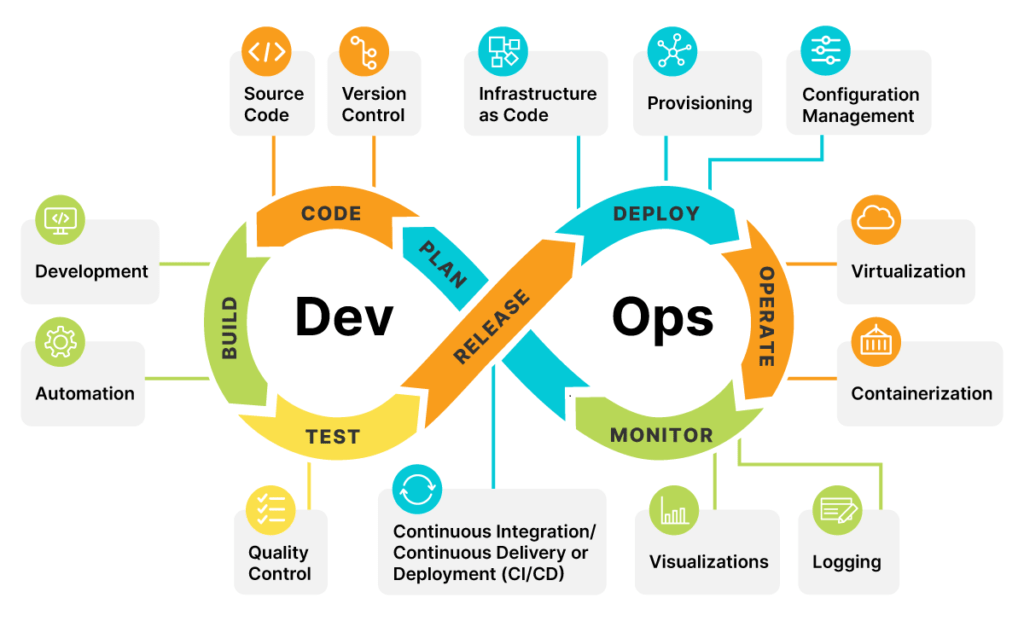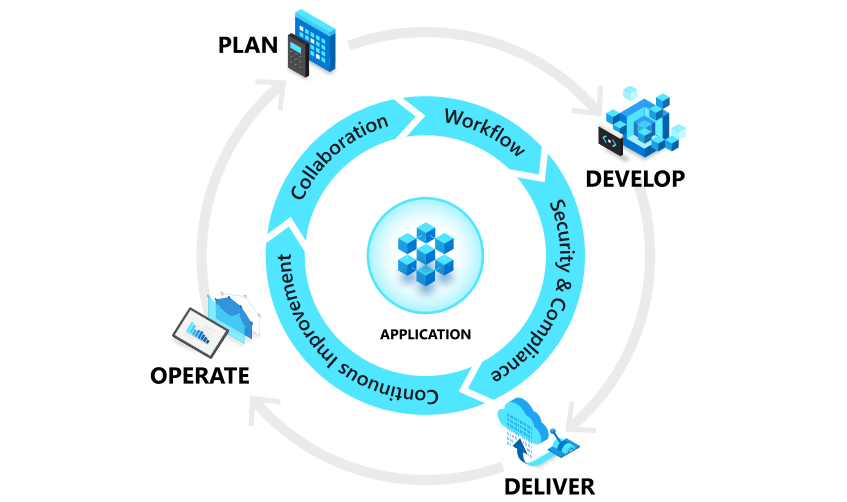
- Introduction to DevOps Lifecycle
- Phases of the DevOps Lifecycle
- Planning and Requirement Gathering
- Development and Source Code Management
- Continuous Integration (CI) Process
- Continuous Testing and Automation
- Continuous Deployment (CD) Strategies
- Infrastructure as Code (IaC) in DevOps
- Monitoring and Logging in DevOps
- Security and Compliance in DevOps Lifecycle
- Future Trends in DevOps Lifecycle
- Conclusion
Introduction to DevOps Lifecycle
The DevOps lifecycle is a set of processes and practices that integrate software development (Dev) and IT operations (Ops) to improve the speed, quality, and efficiency of devops software development lifecycle and delivery. The aim is to create a continuous feedback loop to ensure faster deployment and more frequent software updates while maintaining high levels of quality and security. The Devops lifecycle tools provide a framework that brings together people, processes, and tools for continuous delivery and integration. By adopting DevOps, organizations can break down silos between development and operations teams, automate tasks, and create a more collaborative environment to achieve better results.
Phases of the DevOps Lifecycle
- Planning
- Development
- Continuous Integration (CI)
- Continuous Testing
- Continuous Deployment (CD)
- Infrastructure as Code (IaC)
- Monitoring and Logging
- Security and Compliance
Each stage ensures a smooth and efficient development process and delivers high-quality software that meets end-users’ needs.
Planning and Requirement Gathering
The first phase in the DevOps lifecycle is planning and requirement gathering, which ensures all stakeholders are aligned regarding the project’s objectives, timelines, and expectations. During this phase, developers, product managers, and operations teams come together to discuss and outline key aspects such as the project scope (what is being built and the problem it solves), functional requirements (features and functionality of the application), non-functional requirements (security, performance, scalability, and compliance needs), timeline and milestones (project duration and key deadlines), and collaboration tools (such as Jira, Trello) to ensure smooth communication. This planning phase is critical in setting a clear understanding of the project from the outset. It helps prevent misunderstandings and scope creep later in the project lifecycle. Additionally, it fosters collaboration and ensures that everyone is on the same page regarding expectations. Clear planning also enables the teams to identify potential risks and devise strategies to mitigate them early on. A well-executed planning phase lays the foundation for a successful and efficient devops lifecycle steps process. Lastly, it encourages transparency and accountability, ensuring that all participants are informed and aligned throughout the project.

Development and Source Code Management
In the development phase, teams write code and manage the source code repository. DevOps’s key focus is integrating devops software development lifecycle with operations teams seamlessly. Here, developers use tools such as Git, GitHub, GitLab, or Bitbucket to:
- Version control: Developers manage different codebase versions to ensure multiple developers can collaborate efficiently without code conflicts.
- Collaboration: Developers collaborate using pull requests, code reviews, and branching strategies to improve the code quality and avoid errors.
- Automation: Continuous development includes automating builds and ensuring code quality using tools like Jenkins, Travis CI, and CircleCI.
Continuous Integration (CI) Process
Continuous Integration (CI) involves integrating code changes into a shared repository multiple times a day, with the primary goal of detecting and resolving conflicts early to reduce the time and cost associated with fixing bugs later. Key activities in the CI process include automated builds, where every code commit triggers an automated build process to ensure the new code doesn’t break the DevOps application. Additionally, Continuous testing is carried out, running unit and integration tests to detect bugs early in the development cycle. Continuous feedback is provided to developers, enabling them to address issues quickly and ensuring the codebase remains stable throughout development. CI helps developers work efficiently, preventing conflicts that may arise if different team members work on isolated parts of the code for too long. By continuously integrating and testing Code Management, teams can ensure the quality of their devops software development lifecycle and maintain a smooth, ongoing development flow. It also improves collaboration among developers, as they can identify and fix issues collectively rather than in isolation. Furthermore, CI allows for quicker releases, leading to faster time-to-market for new features.
Continuous Testing and Automation
Continuous testing is a critical phase in the DevOps lifecycle that ensures the quality of the code is maintained throughout the development process. Unlike traditional testing, which occurs at the end of the development cycle, continuous testing occurs continuously during the CI/CD pipeline.
Key aspects of continuous testing:
- Test Automation:Automating unit, integration, and regression tests helps identify bugs early.
- Shift-left testing: Performing tests earlier in the devops software development life cycle helps catch defects early, improve software quality, and reduce testing costs.
- Test environments: Using automated test environments that mimic real-world conditions and different platforms ensures comprehensive testing.
Testing is automated and embedded into the development lifecycle to enable frequent releases of high-quality code with minimal manual intervention.
Continuous Deployment (CD) Strategies
Continuous Deployment (CD) focuses on the deployment aspect of DevOps application, with the goal of automatically deploying changes to production as soon as they pass the required tests. CD strategies include automated deployments using tools like Jenkins, GitLab CI, and Bamboo to automate deployment of DevOps pipeline, ensuring efficient and error-free releases. Canary deployments gradually release the new version to a small subset of users to monitor its impact before deploying it to all users, minimizing risk. Blue-green deployments use two environments (blue and green) to reduce downtime and provide a safer way to deploy new releases, allowing quick rollback if necessary. Rolling updates involve deploying changes incrementally to servers, minimizing downtime and reducing the risk of system outages. These strategies ensure that code changes can be rapidly and safely deployed to production environments, supporting faster delivery of features and bug fixes. Furthermore, CD ensures minimal disruption for end-users, promoting a seamless experience during updates. It also improves collaboration between development and operations teams, as the deployment process becomes automated and streamlined. Additionally, Continuous Deployment supports continuous delivery of value to users, maintaining high levels of product stability.

Infrastructure as Code (IaC) in DevOps
Infrastructure as Code (IaC) is a key principle in devops lifecycle steps that involves managing and provisioning infrastructure through Code Management rather than manual configuration. This allows for automated, consistent, and repeatable infrastructure management. IaC provides benefits like version control, traceability, and automation.
Tools for IaC include:
- Terraform: A tool for defining and provisioning infrastructure using code.
- AWS CloudFormation: A service that provides a way to model and set up AWS resources using code.
- Ansible/Chef/Puppet: Tools that manage configurations, ensuring the infrastructure is in the desired state.
IaC allows teams to manage and scale infrastructure efficiently, making it easier to replicate environments and reduce errors during configuration.
Monitoring and Logging in DevOps
Monitoring and logging are essential components of the Devops lifecycle tools, helping ensure the health and performance of DevOps application and infrastructure. Continuous monitoring enables teams to proactively detect and resolve issues before they impact users.
- Application performance monitoring (APM): Tools like Prometheus, Grafana, and New Relic monitor DevOps application performance and health.
- Log aggregation: Using tools like ELK Stack (Elasticsearch, Logstash, and Kibana) or Splunk to aggregate logs from various services and monitor system activity.
- Alerting and reporting: Automated alerts notify teams of downtime, security breaches, or performance degradation.
Monitoring and logging help DevSecOps teams ensure the system runs smoothly, identify issues early, and provide valuable insights for improvement.
Security and Compliance in DevOps Lifecycle
Security and compliance are critical throughout the entire devops lifecycle steps. DevSecOps is the practice of integrating security practices into the DevOps pipeline from the very beginning.
Key practices for security and compliance include:
- Shift-Left Security: Integrating security testing into early stages of development (e.g., static code analysis, vulnerability scanning).
- Automated Security Testing: Using automated tools to scan code for vulnerabilities, misconfigurations, and potential security threats.
- Continuous Compliance: Ensuring that systems meet regulatory requirements by automating compliance checks.
- Identity and Access Management (IAM): Managing and controlling resource access using policies and least privilege principles.
Best practices to overcome these challenges
- Collaboration Foster a culture of collaboration between development, operations, and security teams.
- Start small: Implement DevSecOps practices incrementally, starting with a pilot project and expanding as you gain experience.
- Continuous learning: Keep up with evolving DevOps tools, technologies, and best practices.
- Automation first: Automate as much as possible to reduce manual errors and improve efficiency.
Future Trends in the DevOps Lifecycle
The DevOps lifecycle is evolving with the increasing adoption of new technologies. AI and Machine Learning: Integrating AI/ML into DevOps processes for more intelligent automation, anomaly detection, and predictive analytics.Serverless computing the rise of serverless architectures reduces the overhead of managing infrastructure, allowing DevOps teams to focus on development and operations.DevOps for security (DevSecOps): Increased focus on embedding security into the DevOps process to meet regulatory and industry standards.Microservices and Containers: The growing adoption of microservices architecture and containerization using Docker and Kubernetes for efficient deployment.
Conclusion
TheDevops lifecycle tools are integral to modern software development, offering significant benefits like faster development cycles, better quality, and improved collaboration. Implementing each phase of planning, development, CI/CD, IaC, monitoring, and security teams can streamline their development processes and deliver high-quality applications. The future of DevOps will continue to evolve with new technologies and practices, making it an exciting and dynamic field for developers and IT professionals.





